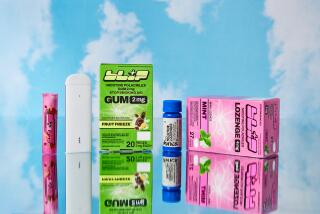Toy Firm Turns Popular Mint Strip Into Child’s Play
In his quest to create the hottest edible toy since the whirling lollipop, no detail has been too trivial for Michael Bianco, chief merchandising officer of Malibu-based toy maker Jakks Pacific Inc.
So Bianco appointed himself Jakks’ chief taste tester and, in that capacity, rejected a grape candy sample as too gritty, a blue raspberry for being too sticky and an orange attempt as too flimsy. Would-be cherry versions were nixed for being too bitter, too brittle, too brown or too pink.
Bianco’s goal? An elusive candy version of the dissolving breath-freshening strips popular with adults.
And after more than a year of tasting, tossing out and trying again, he thinks he’s got it -- and that the kids of America will want it. The product is set to begin showing up on select toy store shelves this week.
What might sound like a silly endeavor is a potential Holy Grail to those in the business of selling to children. Done right, the candy strips could be a kind of modern-day bubblegum cigar and Pez dispenser rolled into one: a kid version of an adult product that’s also fun to collect.
“When I saw it, I thought, they’re going to sell millions of these things and make a ton of money,” said Sean McGowan, a toy industry analyst with Gerard Klauer Mattison in New York. “It puts a bunch of the right things together -- it’s a toy and a collectible and a cool, Space-Age-like candy. What more do you need?”
Still, there’s also the potential for Jakks to wind up with another flash fad or an all-out dud. Candy counters and toy aisles across the country are overstuffed with companies’ hopes for the next big craze. Jakks won’t say how much it spent to develop the candy -- its first foray into an edible plaything -- but says the product is the company’s biggest launch of a nonlicensed toy.
So far, Jakks has met the first big challenge: whetting the appetite of a few key buyers.
After running what it’s calling Tongue Tape by just a few retailers, Jakks says it has landed orders for more than 5 million units during the first quarter of next year alone. And that was without being able to show buyers the final product, which was still in development.
Trying to turn a toy into a hit is part whimsy and part work. Fads often come out of nowhere, as with Beanie Babies and Cabbage Patch dolls. Other times, the winners are carefully plotted.
In the case of Tongue Tape, Jakks is hoping to exploit the popularity of adult products: Pfizer Inc.’s Listerine PocketPaks, introduced about 18 months ago, and Wm. Wrigley Jr. Co.’s Eclipse Flash Strips, in cinnamon and peppermint flavors, which followed last summer.
Already, consumers have snapped up more than 200 million Listerine strip packages alone, according to Pfizer. With different-size packages selling at $1.50 to $6 a pop, that means hundreds of millions of dollars in retail sales.
To a toy or candy maker, that’s enough to signal that a product is ripe for an extension into the kid market. (Neither Pfizer, which recently sold off its candy unit, nor Wrigley would discuss their own plans for new flavors.)
It was the same route traveled by the ultimate in candy toys, Pez, the edible pellets of which Americans buy 3 billion each year. The fruit-flavored candy, which is packaged as a toy, also began as a minty product; the name Pez, coined 70 years ago in Austria, comes from Pfefferminz, German for peppermint.
Of course, most toys -- from cars to baby dolls -- are pint-size versions of adult products or interests.
“When I was a kid there were candy cigarettes,” said M. Eric Johnson, a professor at Dartmouth’s Tuck School of Management, who studies the toy industry. “Toys prepare you for adulthood. It allows kids to play out adult life through the toys. Even the simplest, youngest toys are after that idea.”
For Jakks -- which after a series of acquisitions this year became the nation’s third-largest toy company, behind Mattel Inc. and Hasbro Inc. -- this particular take on an adult product is part of a broader objective. Jakks wants to offer a range of products that sell strongly all year long, not just during the Christmas shopping season.
So far, Jakks, best known for its professional wrestling action figures and Flying Colors activity sets, has tried to reach this goal through mergers. With the 2000 addition of Pentech, which brought gel pens and stationery under the Jakks umbrella, the company gained access to the lucrative back-to-school market and claimed new shelf space at general merchandise and office-supply stores.
Then in 2002, Jakks added Toymax International, the creator of Go Fly a Kite and Funnoodle products, including kites and pool floats that sell well in the summer. This month, Jakks built on its summer offerings, announcing the purchase of the water guns, play sets and other assets of privately held Trendmasters.
With Tongue Tape, Jakks’ plan is to construct its own line of products with year-round appeal.
Jakks, though consistently profitable, lags far behind the toy industry’s multibillion-dollar leaders, estimating its 2002 revenue at $310 million to $330 million. The company, which went public in 1996, has seen its stock up 27% this year, closing Friday at $13.70 on Nasdaq. But shares are down from a 52-week high of $23.70 reached in March.
Toy industry analyst McGowan and others say Jakks’ strongest moves so far have been in following Mattel’s and Hasbro’s model of establishing a broad stable of brands and products. A hit candy toy, McGowan said, would mark another smart step in line with that strategy.
Trying to create Tongue Tape, however, was anything but child’s play. And Jakks got word early on that others were on the hunt.
When Jakks contacted edible plastic film producers from around the world, several said they were already working on candy strips for other candy and novelty companies and expected to ship them within weeks.
“That was eight months ago,” Bianco said, sitting in his ocean-front Malibu office and smiling. “They still haven’t.”
To make the breath-freshening strips, an oil-based flavoring is added to oil-based film, a fairly simple process. The problem is that most candy flavors are water based. And as most of Jakks’ target audience knows, oil and water don’t mix.
Just adding sugar to an oil flavoring doesn’t work either because the thin, wispy films don’t have enough mass to hold the dense sweetener.
So Bianco and his chemists began toying more than a year ago with a starch-based medium. That kind of product has worked well for Hasbro, which used a similar type of base for its Nibble Notes, an edible pad of paper with an accompanying food-color marker.
The problem with a starch base is that it didn’t have the see-through, melt-away qualities of the product that Jakks wanted to mimic. Nor was Bianco pleased with what he thought was a Styrofoam-like taste.
“I’m an old Catholic, so I know -- this tasted like a host,” Bianco said.
Jakks moved on to other bases and combinations, using edible, food-grade plastics already FDA-approved for use in wrapping meats and other grocery products.
To speed the process, Bianco signed three manufacturers -- one in the United States, one in Canada and one in Japan -- to their own contest for the right formula.
A Japanese-made candy film was too gritty and gluey. Various other companies’ combinations of plastics and starches made the product too thin, brittle or flavorless.
As the companies began shipping sample after sample to Bianco, Jakks’ chemists were also experimenting with ways to create a sweet candy flavor. The first trick the chemists and edible film companies employed was using artificial sweeteners, which are much thinner and more easily manipulated than the denser traditional sugar.
The problem was the bitter aftertaste, an unpleasant sensation that harkens back to the early days of sugar substitutes made for coffee and diet sodas.
The various Jakks-contracted scientists found a way around that by trying different amounts of citric and tannic acids. Though bitter in their own right, the acids have the effect of enhancing the sugary taste of Aspartame while cutting its bitter residue, similar to the way salt brings out the sweetness in watermelon and tomatoes.
Cherry was the toughest to crack. If the flavoring isn’t just right, a slightly off cherry has an unpleasant association for many consumers -- what Bianco calls the “cough syrup factor.” And that’s how the first versions turned out, with a bitter and medicinal taste.
To show how far the products have come in just a few short months, Bianco dug through a bunch of plastic bags until he found one filled with a day-glow green film. This, he said, was supposed to be either green apple or watermelon, though he couldn’t remember which until he put it in his mouth. “Sour green apple,” he said, swirling the candy through his mouth like a sommelier tasting a fine wine.
“Ahh, the worst of all worlds -- gluey and bad flavor!” Bianco proclaimed.
Finally, just a few weeks ago, Jakks thought its chemists and one of the film companies finally hit on the right formulas.
Shortly thereafter, Bianco met with buyers from KB Toys, carrying a lunchbox filled with eight Ziploc bags of his flavored films and mock packages cut out of foam and covered with hand-drawn designs.
By the time the meeting was over, he had an order for $1 million worth of the product.
Kmart and Toys R Us also placed orders through the first quarter on the basis of samples and drawings, Jakks said.
“It dissolves so quickly in your mouth but leaves a lasting flavor. That’s cool,” said KB’s merchandise manager, C.B. Alberts. “I brought a couple pieces back to my daughter and her friends -- they’re 12 -- and they thought it was very cool. They already like the Listerine things, and that isn’t for the taste.”
The various flavors are housed in plastic containers similar to those of the breath fresheners, but with different cartoon-like decorations, each sporting a giant tongue that reinforces the names: Growlin’ Grape, Lip-Lemony-Lemon, Cherry Pit Stop, Blue Ratsberry, Cinna-Bomb and Ooh-Ooh Orange. Jakks is working to perfect a sour line for the next installment of Tongue Tape.
Jakks’ suggested retail price for a basic container of 24 strips of Tongue Tape is $1.99. A deluxe package for $3.99 will include 36 strips and a necklace, key chain, ring or zipper pull holder.
Bianco spun off a list of possibilities for the next group of dispensers, with the tape coming out of wheels on a car, an action figure’s backpack or the hood of a toy automobile. Jakks could sell Tongue Tape in reels, rolls and printed sheets, he added.
For now, though, the ideas are as basic as the once-humble Pez dispenser.
“We’re relatively simple folk around here,” Bianco said.
“We tend to shy away from cutting-edge technology.... Kids are kids and they like good, basic, fun things.
“And they like candy.”


